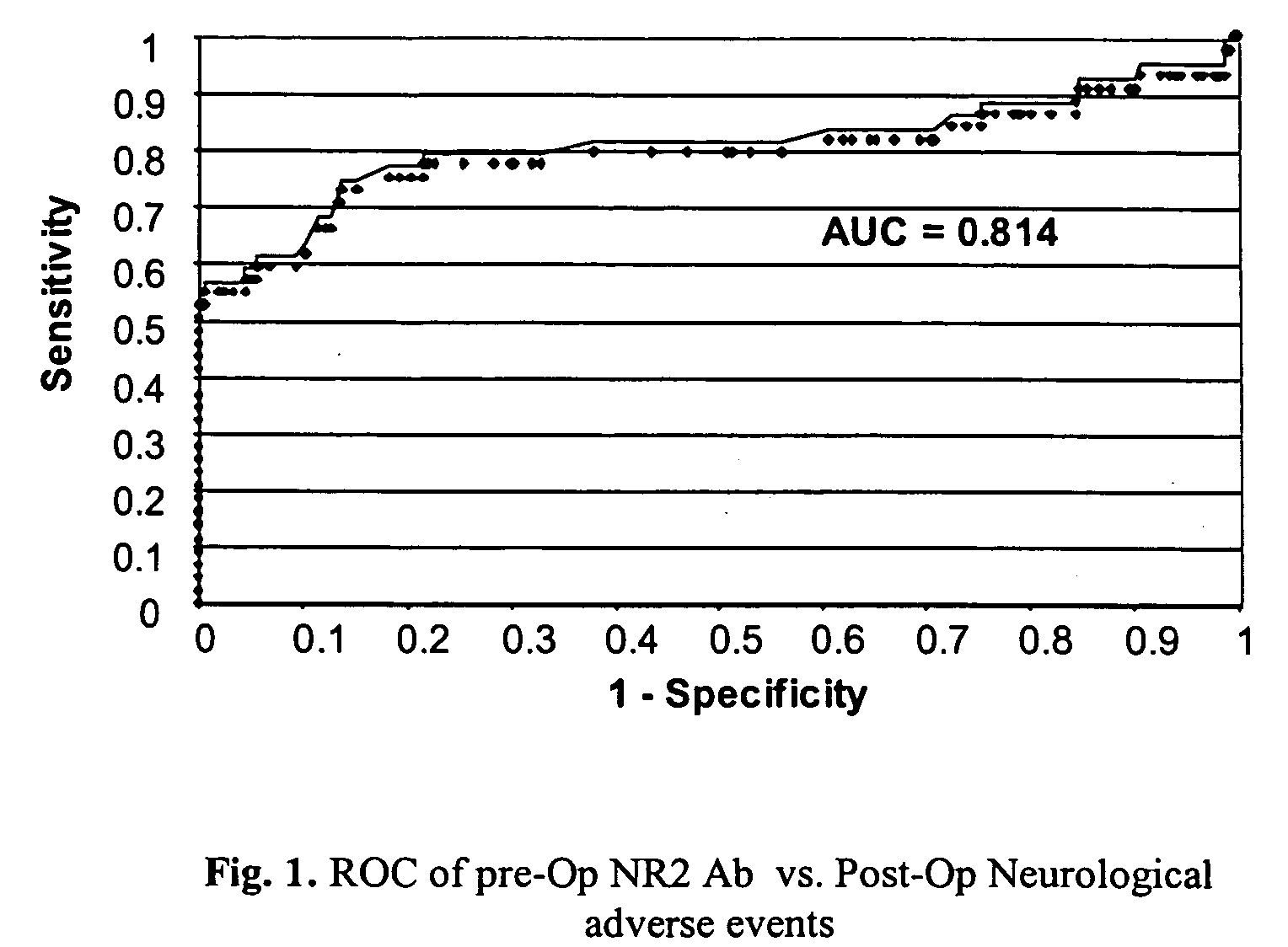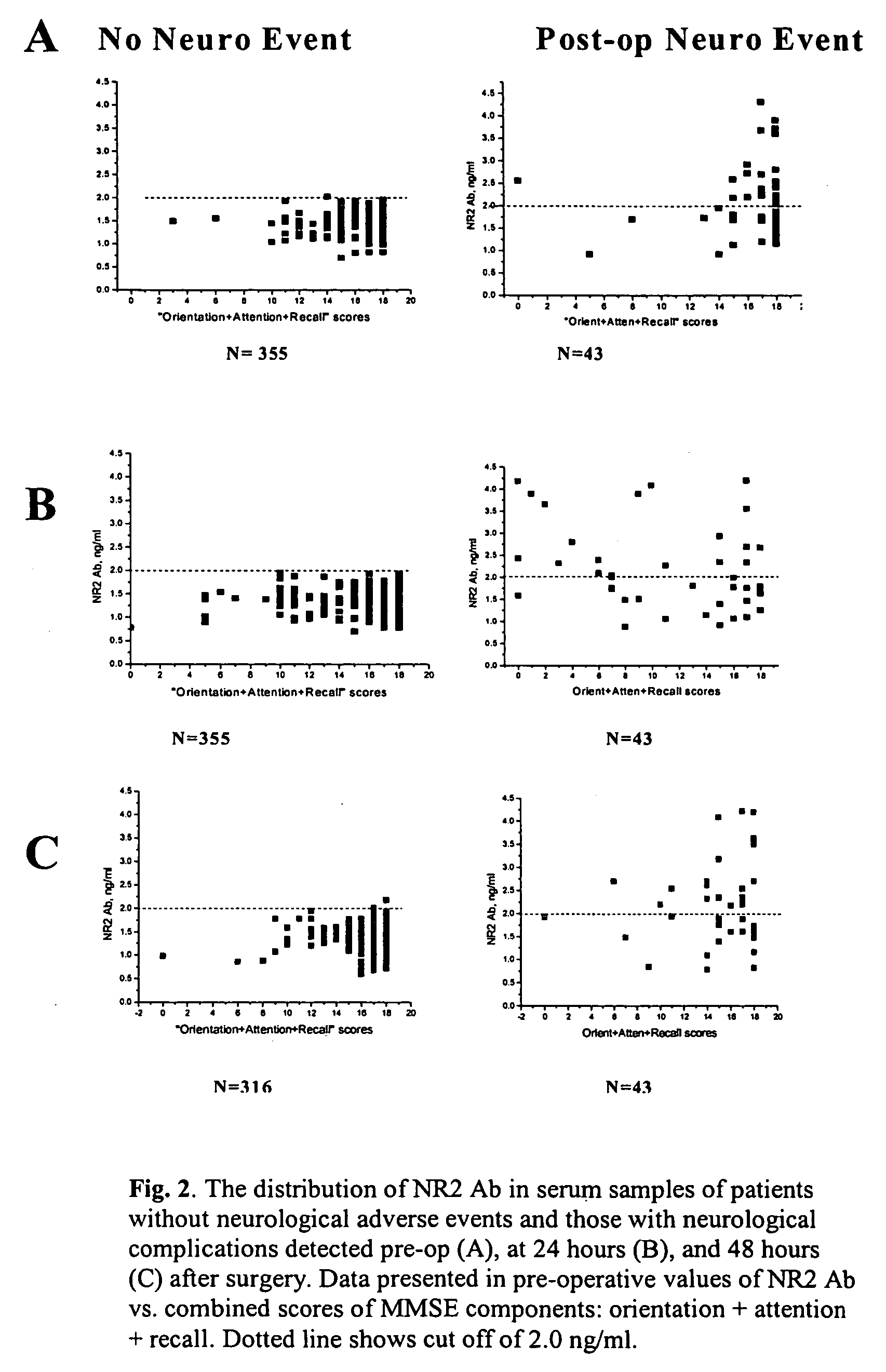Ischemic biomarkers and their use to predict adverse neurological events from surgery
a biomarker and ischemic technology, applied in the direction of biological material analysis, instruments, measurement devices, etc., can solve the problems of insufficient blood supply to the brain, damage to the nervous system, and condition known as ischemia, and achieve the effect of accurately predicting the risk of adverse neurological events
- Summary
- Abstract
- Description
- Claims
- Application Information
AI Technical Summary
Benefits of technology
Problems solved by technology
Method used
Image
Examples
example 1
NMDA Peptide Test
[0054] A preferred NR2 peptide test is a latex agglutination immunoassay for the qualitative determination of NR2 peptide in the blood. Blood samples are mixed with antibody coupled to latex beads and agglutination is visually detected within 10 minutes. After addition of a blood sample to the sample port of the test device, the red blood cells are separated from plasma by a filter. A predetermined quantity of plasma moves by capillary action into a reaction chamber, where it reacts with latex reagent (antibody-coated latex beads) to form complexes that can be detected visually. In the examples reported herein, the test uses calibrators set from 100-5000 pg / ml and standards with “low” (<200 pg / ml) and “high” (1000 pg / ml) values of NR2 peptide.
example 2
NMDA Antibody Test
[0055] A rapid assay of NR2 antibody assay (CIS-LA antibody test) is based on a latex agglutination technique. The CIS-LA antibody assay employs triple concave slides with a built-in magnification device to detect the reaction visually, providing an immediate “yes” or “no” response. In this assay, serum samples are mixed with NR2 peptide coupled with colored latex particles and agglutination is visually detected through built-in magnification device within 2 to 5 minutes or is indicated using nephelometer. The IgG concentrations in patient samples is expressed in ng / ml according to a calibration curve from a set of calibrators of 0-100 ng / ml and standards with “low” (<2.0 ng / ml) and “high” (6 ng / ml) values of NR2 antibodies.
example 3
Evaluation of NR2 Antibodies in Adult Surgery Patients
[0056] Thirty adult patients scheduled for CPB surgery were evaluated for NR2 antibody levels in serum before the surgery, 24 hours after surgery, and 48 hour after surgery, and adverse events recorded. Results are presented below in Table 1.
TABLE 1NR2 antibody, mean ± SD, ng / mlNo.pre24 h post48 h postSurgery typeAdverse events11.70 ± 0.141.58 ± 0.121.55 ± 0.13Valve1st postop hemorr.21.79 ± 0.101.64 ± 0.032.76 ± 0.08CABG1st-3rd postop, C32.25 ± 0.021.812.14 ± 0.03CABG + valve2nd postop, C (hr)42.00 ± 0.043.23 ± 0.093.34 ± 0.15CABG3rd-5th postop, C5 3.9 ± 0.082.32 ± 0.062.70 ± 0.15CABG2nd postop, IS6 5.4 ± 0.124.65 ± 0.094.60 ± 0.25CABG + valve2nd postop, C&D, DM72.29 ± 0.092.05 ± 0.022.20 ± 0.02CABGPreop, *C81.69 ± 0.02 1.35 ± 0.0041.22 ± 0.07CABG + valve3rd postop, C (hr)91.94 ± 0.03 1.69 ± 0.0051.38 ± 0.03Valve2nd postop, C (4 hr)101.78 ± 0.141.89 ± 0.041.65CABG + valve1st postop, **, DM111.70 ± 0.03 2.00 ± 0.0062.35 ± 0.24C...
PUM
| Property | Measurement | Unit |
|---|---|---|
| time | aaaaa | aaaaa |
| time | aaaaa | aaaaa |
| time | aaaaa | aaaaa |
Abstract
Description
Claims
Application Information
 Login to View More
Login to View More - R&D
- Intellectual Property
- Life Sciences
- Materials
- Tech Scout
- Unparalleled Data Quality
- Higher Quality Content
- 60% Fewer Hallucinations
Browse by: Latest US Patents, China's latest patents, Technical Efficacy Thesaurus, Application Domain, Technology Topic, Popular Technical Reports.
© 2025 PatSnap. All rights reserved.Legal|Privacy policy|Modern Slavery Act Transparency Statement|Sitemap|About US| Contact US: help@patsnap.com


